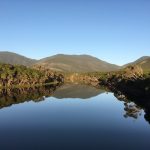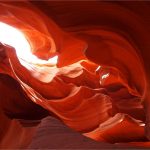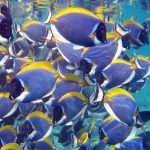
We had been to Iceland already last year – but in times of the Corona Pandemic the remote island appeared the perfect destination: a lot of landscape and few people. This time, we focused on our favorite spots on the south coast (part 1, this blog post) and spots in central iceland beyond the ring road, that we could not visit last time due to the lack of a 4 wheel-drive (part 2).
Anzeige*
| Destination |
Vík í Mýrdal, Iceland |
| How I got there | direct flights from Duesseldorf with Iceland Air |
| Where I stayed and Hotel recommendations | We stayed at a very comfortable Hotel near Vík í Mýrdal: the “Black Beach Suites” Hotel; there are several other guesthouses and hotels available in the area. The only Hotel close to Jökulsarlon lagoon is the Fosshotel Glacier Lagoon.
Hotel Geysir: we booked the “Geysir Cottages”, but due to the Corona Pandemic all guests in the area were re-located to the Hotel Geyser, which is a nice and comfortable 4-star hotel. |
| Restaurants | Fjorubordid: excellent Restaurant in Stokkseyri village on the south-western coast; disganture dish: lobster soup
Minilik: ethiopean Restaurant in Fludir; cosy atmosphere; the cook is Ethiopean, her husband serves the excellent dishes; very reasonably priced! After dinner ethiopean coffee beans are roasted and original african coffee is offered; all guest sit around the cook – very nice and unexpected experience in Iceland! Highly recommended. Smidjan Brugghus: quite large brewery in Vic i Myrdal, casual, usually well frewuented by the locals Fosshotel Glacier Lagoon Restaurant: the restaurant closest to Jökulsarlon, good price-quality ratio Kaffiterían Skaftafelli: canteen-like self service restaurant, not really recommended, just used due to the unrivaled location in the Skaftafell National Park Papa’s Restaurant: small place at the Gridavik Harbour Veitingahusid Bruin: large Restaurant in Grindavik; OK quality, reasonably priced Geysir Restaurant: large Restaurant in the Geysir Hotel (see above) Restaurant at the Kerlingarfjoll Mountain Resort: small Restaurant at the small geusthouse at the Kerlingarfjöll thermal area |
| Things to do | See ice caves; we did with “Arctic Adventures” who were the only ones offering an ice cave tour in summer
Walk on a glacier; there are several tour providers; we went (again) with Arctic Adenvtures, the tour was in the Skaftafell National Park (we recommend this and not the Solheimajokull glacier walk) Walk on the Black Beach Enjoy the colorful mountains around Landmannalaugar and explore the hot springs at Kerlingarfjöll Visit the numerous waterfalls of Iceland Find the magic valley of Gjain Discover Thorsmörk |
| Recommendations in a nutshell | Invest money in a four-wheel drive andexplore the fantastic Icelandic landscape beyond the ring road. |
| recipe | “canilsnugar” – crispy cinnamon rolls, perfectly prepared by the bakery “Braud & Co.“ |
Vík í Mýrdal – the most southern town of Iceland
Vic is a small town – in fact, rather a village with only a little over 300 inhabitants. However, it’s location on the ring road brings most tourists at least once to the village, and many stay over night, as there are only few other opportunities to stay on the south coast. And Vic offers everything you need – restaurants, supermarkets, a petrol station, even a “vinbudin” – a liqueur store, if you are up to spend a fortune on local beer or imported wines.
Besides these commodities, Vic is a good base for exploring the fantastic sights of the Icelandis south coast. We chose the the “Black Beach Suites” Hotel, because of it’s location about 6 km from Vic and just 3 km above Reynisfjara, with a great view of the Dyrholae Peninsula:

The rooms are in fact small apartments and provide everything for a self-sustained stay. And a lovely view to the sea on one side and to the glaciers and mountains on the other side, including almost midnight sun (the picture below was taken around 11 pm):
 |
 |
Reynisfjara and Reynisdrangar
The famous “Reynisdrangar” basalt rocks on the equally famous “Reynisfjara” black beach are just a few minutes away.

The beach offers numerous motives for interesting pictures, of the rocks…
 |
 |
 |
At the cave, quite close to the beach entrance, the basalt structure is nicely visible:
 |
 |
And it is worth to look into the sky at Reyynisfjara: there are thousands of puffins that nest on the rocks above the beach:
 |
 |
 |
 |
Reynisfjara beach is also acessible from the Vic y Myrdal side. It is a slightly longer walk from the village, but equally rewarding, and provides a nice view back to Vic:

Dyrholae
One of the attractions closest to Vic is the Dyrholae Peninsula. You can either visit the cliff from the beach below or from above, which gives a great view from Reynisfjara beach up to the Myrdalsjökull Glacier.
 |
 |
 |
 |
Solheimajökull
Nearby Dyrholae is the easiest access to a glacier that you can visit without booking any tour: the Solheimajökull Glacier, which is part of the Myrdalsjökull. Solheimajökull is accessible via a dirt road, but by a regular (non-four-wheel) car.

At the end of the road you’ll have to walk for about 20 minutes to get to the glacier front. Somewhere there is a sign…

…asking you not to walk any further. However, everybody does, and to us it seemed quite save (sunny weather) to continue. A little further there is already the ice, which is covered with black sand:
 |
 |
 |
 |
Ice Cave at Myrdalsjökull
What should not be done without any experienced guide is the visit of an ice cave. In fact, all the tourist guides reported that there would not be any ice cave accessible during the summer months. However, Artic Adventures offered a trip, and we were not disappointed.
It started at Vic y Myrdal by a sort of “monster bus”, that is needed for the required offroad trip:

After a few kilometers on the ring road, we went to the left and then over the plain up to the black glacier front of Myrdalsjökull (this time the eastern side, not the Solheimajökull side).

Finally, we reached our destination, left the car, were equipped with all the necessary safety gear (helmets, cranks for the shoes etc.) and walked towards the ice front. In there, two cave entrances were visible:
 |
 |
 |
 |
We went to the right of the two entrances. The left one turned out to be just an arch – the left-overs of a previous cave that had already melted and could not be visited any longer. Also “our” cave was heavily melting – the water came down in streams, and I guess it is gone within a few weeks:
 |
 |
The entrance itself was made accessible by wooden boards that we had to balance over:
 |
 |
However, the view back was gorgeous:

As was the cave itself – absolutely amazing!!

Only small groups of maximum four people could get into the cave due to limited space, but once inside, it was really worth the money and effort. The structure of the ice is amazing:
 |
 |
 |
 |
On our way back we could take some more pictures of the plain next to the glacier. One of the most fascinating features of Islandic landscape is – at least for me – the incredible vastness of the plains.
Þakgil
This vastness can also very nicely be observed when going to Thakgil (Þakgil in Islandic letters):

Thakgil lies at the end of a small dirt road and definitely requires a four-wheel drive. However, the surounding mountains and the vast plains of the glacial rivers are absolutely worth the bumpy ride. From above, even the Dyrholae Peninsula could be seen far away:
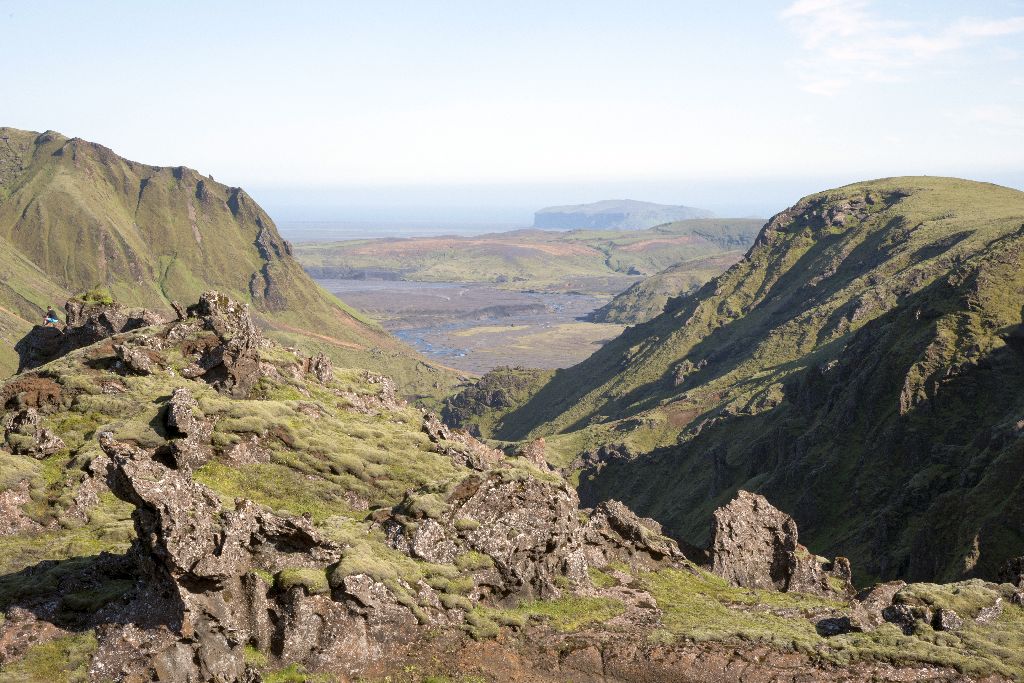
Our first plan – walking deeper into the valley by following the small river – was spoilt by the closure of the walk. So, we just took some pictures.
 |
 |
 |
 |
Instead, we drove back a little bit and walked into one of the other valleys nearby:
 |
 |
 |
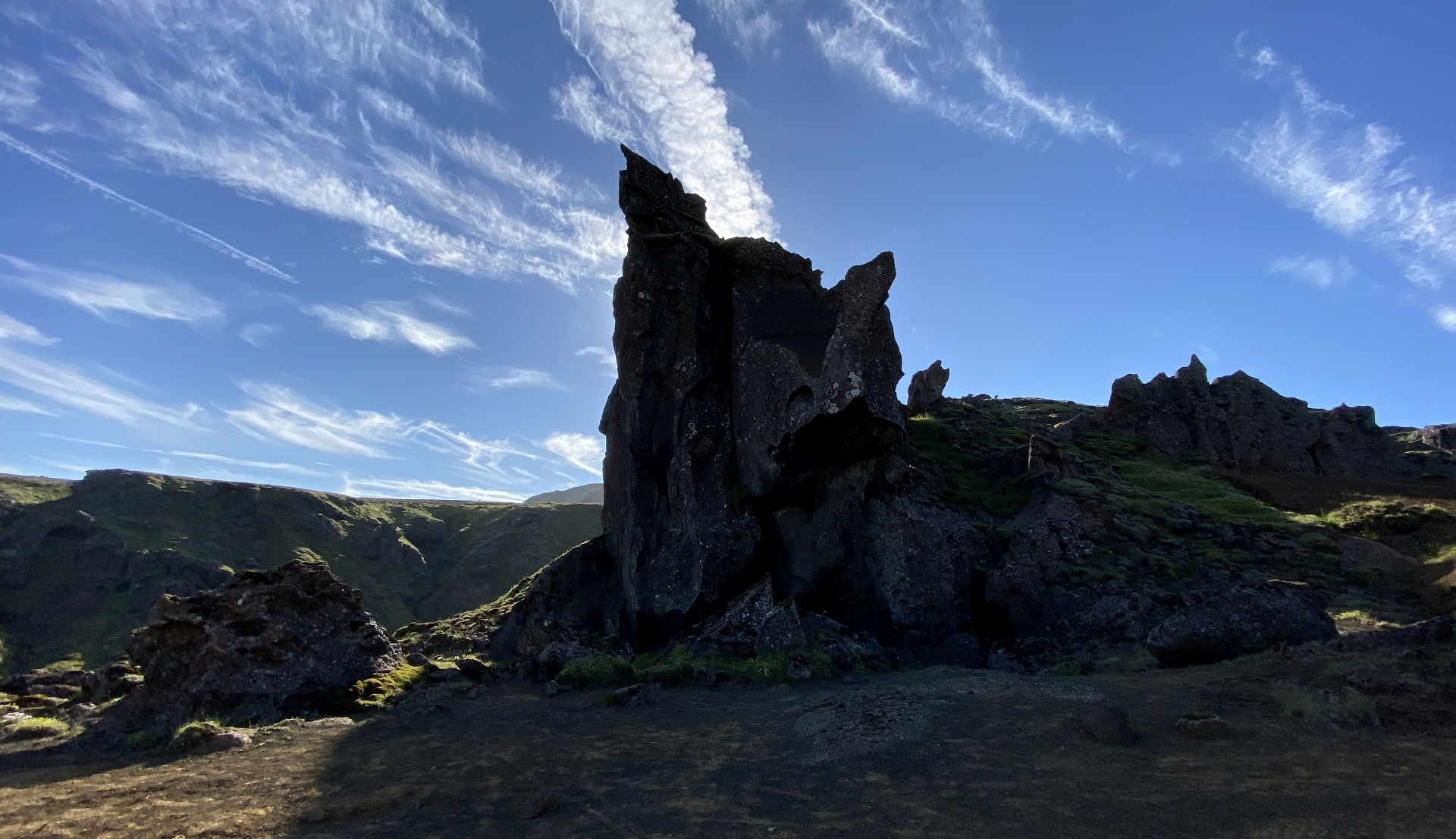 |
On the way back we took some more pictures of the glacial plain next to the road:


Fortunately, there are no rivers to cross; instead there are bridges. And surprisingly heavy traffic:

Glacier Hike on Vatnajökull
Another trip that should definitely not be missed, was the Glacier Hike that we also booked with artic Adventures. The trip started at Skaftafell National Park and took us – if I remember correctly – to “Falljökull” which is one of the many arms of the Vatnajökull, the biggest Glacier of Europe.
We left the cars below the glacier lake at the bottom of the glacier, were equipped with the “glacier gear” (e.g. helmets, cranks etc.), passed the lake and approached the border of the ice. Then we went straight up the glacier:
 |
 |
 |
 |
Unfortunately, the weather changed and went forth and back from cloudy to really foggy. But still, the glacial caves and crevasses were quite impressive.
 |
 |
 |
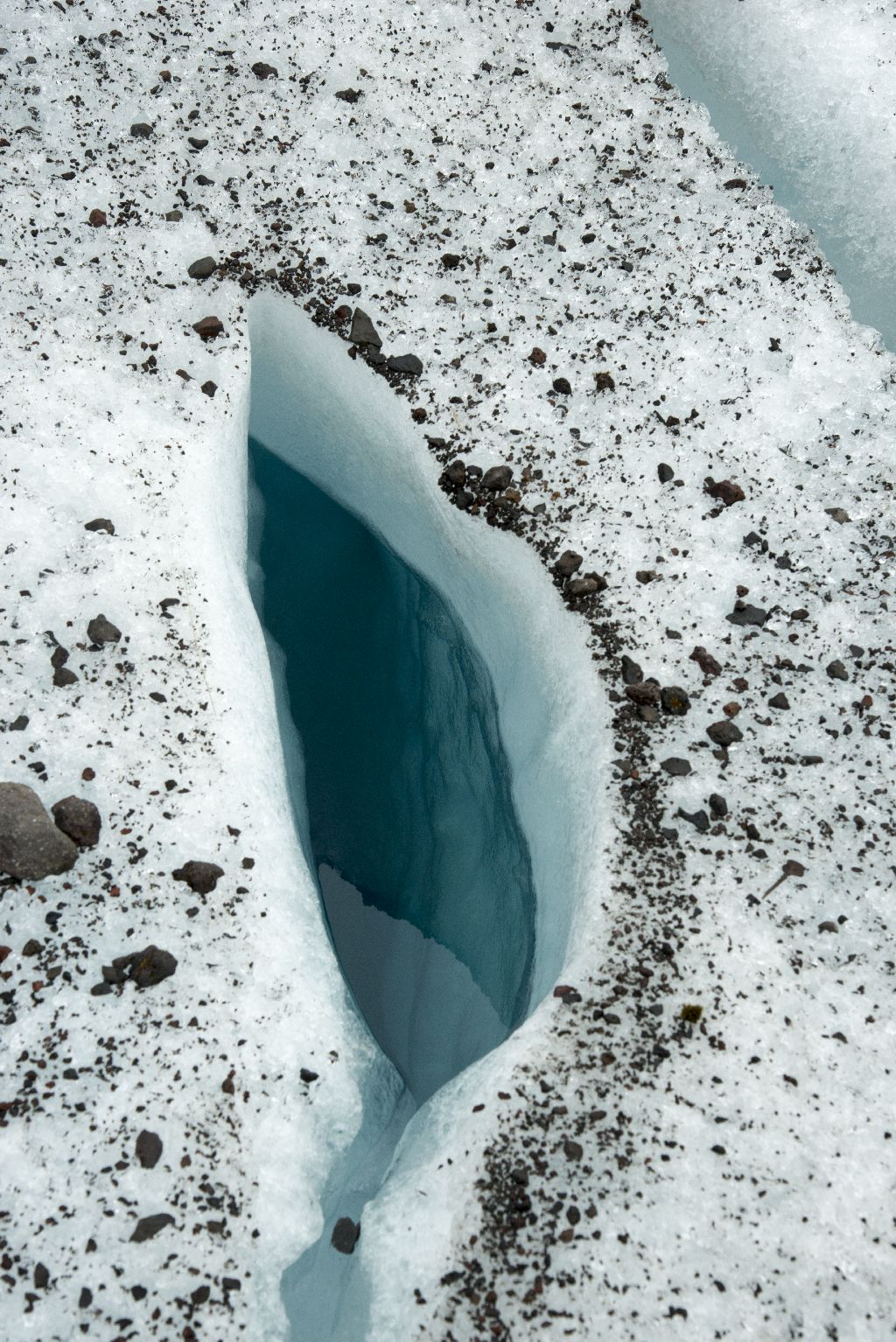 |
However, sometimes we did get even some sunshine:

The true dimensions of this huge glacier cannot be captured by fotos, you’ll have to see it yourself.
 |
 |
On our way back, our guide explained the small volcano-like structures everywhere on the ice, which are in fact small ice cones:
 |
 |
 |
This is definitely an experience that should not be missed. As is the next one, the Jökulsarlon Glacier Lagoon.
Jöjulsarlon Glacier Lagoon
Last year the Jökulsarlon Lagoon had already been of our absolute favorite places, and thus we were really looking forward to this year’s visit, and this time we booked the Zodiac tour on the lagoon.
First we went to the “Diamond Beach”, where the icebergs from the lagoon run ashore and form fascinating ice sculptures. Here is just a small variety of the numerous pictures we took:

 |
 |
And many people use the extraordinary surrounding for unforgettable pictures:
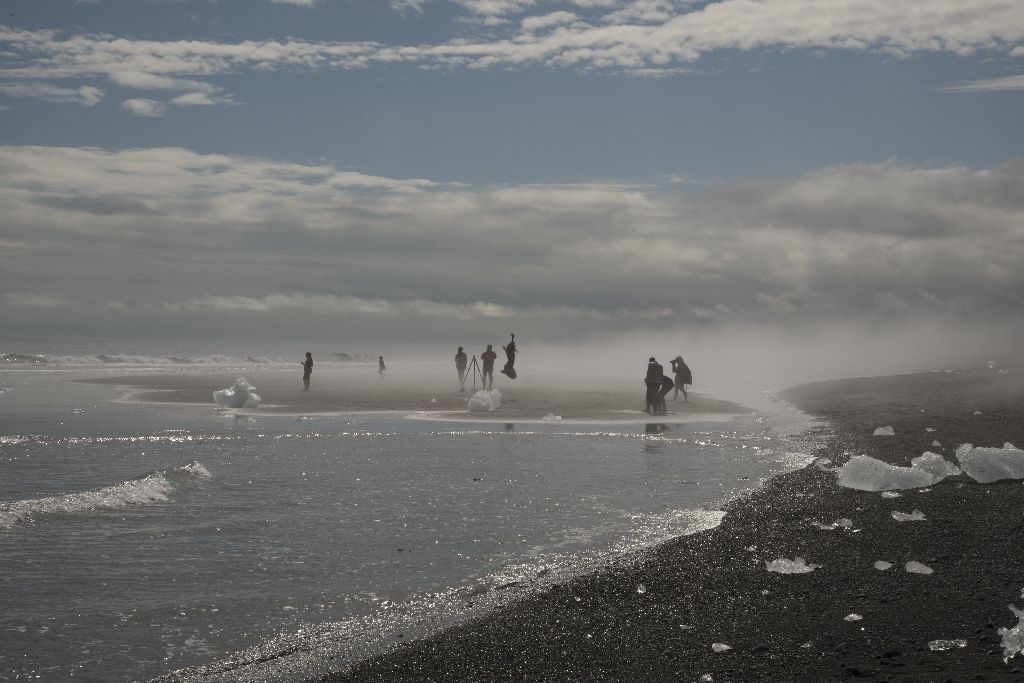
The fog, the light and the reflexions produce really nice pictures:
 |
 |
However, the Glacier Lagoon itself is even more fascinating:

The icebergs come in many different shapes and colors, the dark one below resembling a dinosaur:
 |
 |
 |
Taking the Zodiac tour was a good idea, as it brings you very close to the glacier front. And allows for snapshots on the way:
 |
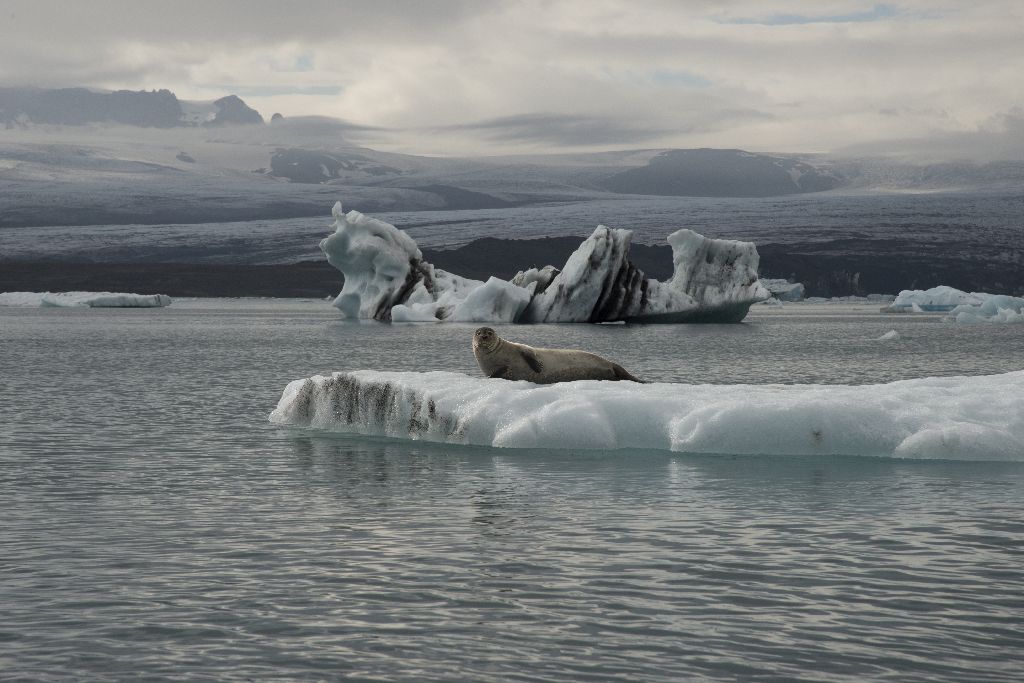 |
 |
 |
Jökulsarlon is one of my favorite places in the world and whenever I come back to Iceland, I am sure to visit it.

If Jökulsarlon should be too crowded for your taste, then you should visit Fjallsarlon – a similar Glacier Lagoon at the bottom of Fjalljökull. A bit smaller, a bit less spectacular, but way less crowded. And also very beautiful:


And two (smaller) attraction on the way back from Jökulsarlon to Vic: the so-called “Eldrhaun” field is a huge lava field just west of Kirkjubæjarklaustur, that streches along the ring road for about 20 km.

The lava stones are covered with a thick layer of moss, which gives it a strange look:
 |
 |
 |
And there are so-called “Pseudo-Craters” right next to the ring road, about 20 km east of Vic: tiny crater-like hills that form a “miniature volcano landscape”:

There are many of these “craters in the area, some bigger, and some really tiny ones:
 |
 |
Passing cars provide nice sights:

This finishes part 1 of our 2020 Iceland trip – please see part 2 for the central parts of Iceland!
| This is part 1 of our Iceland 2020 trip: Vic y Myrdal, Dyrholae, Solheimajökul, Thakgil, Ice Cave, Glacier Hike on Vatnajökull, Jökulsarlon Glacier Lagoon, Diamond Beach, Eldrhaun, Pseudocraters | Part 2 of our Iceland 2020 trip: Thorsmörk, Landmannalaugar, Kerlingarfjöll, Geysir, Reykjanes Peninsula |
I’m having some problems with a recipe recommendation…so far we did not discover anything special about the Icelandic kitchen (as I’m not eating any fish or seafood), but we liked very much the wonderful, crispy “Canilsnugar” – cinnamon rolls.
Recipe: Canilsnugar – Icelandic Cinnamon Rolls
Ingredients
Dough:
- 40 g fresh yeast
- 500 ml whole milk, handwarm
- 150 g soft butter (at room temperature)
- 75 g caster or granulated sugar
- 800 g wheat flour (preferably a baking sort like “pizza flour” or “bread flour”, e. g. no.550)
- 1 tsp salt
- 1 egg and 1 egg yolk (at room temperature)
Filling:
- 200 g soft butter
- 2 tbsp ground cinnamon
- 1 package vanilla sugar
- 200 g soft brown sugar
- 1 beaten egg for brushing
- Decoration: Sugar beet Syrup, Maple syrup or Date Syrup (150 ml, heated to become liquid) mixed with Caster sugar
Instructions
- Dissolve yeast in the warm milk, pour the mixture into the flour and leave it for 15 minutes.
- Mix in the soft butter and sugar and knead the dough until it is homogenous and a bit sticky. Put it in a warm place, like the pre-heated oven at 40 degrees centigrade. Allow the dough to rise for around 30 minutes.
- Dust a table top with flour, put the dough on the floured surface and knead the dough slightly. Cut the dough into two equal pieces.
- Roll out the two lumps of dough to baking tray size.
- Mix together all ingredients of the filling and spread it across the two dough “plates”.
- Roll each gough “plate” lengthwise into a roll and cut it into approx.. 15 slices. Pleace each slice on a baking tray.
- Let helical slices rise for another 20 minutes, then bruch with the beaten egg.
- Bake the cinnamon rolls in the pre-heated oven (180 degrees Celsius with fan; 200 degrees without fan) for 7-8 minutes (it is advised to watch them in order not to burn them).
- Immediately after baking brush lightly with the syrup-granulated sugar mixture.
Greetings from Iceland!

*According to a German Court decision, all texts containing links to commercial pages (e.g. links to Tripadvisor, Airline, hotel or restaurant websites) have to be identified as “commercial” (in German “Anzeige”). As my texts do contain links like that, I therefore identify each post and page containing a link as “Anzeige”. However (and referring to the “About Me” page) I would like to point out that I do NOT post any sponsored content in my texts. I pay for all my trips myself.



